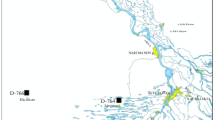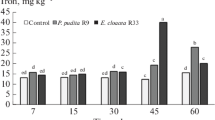Summary
Brown soil formed from loamy clay was examined for its ability to produce sulphate from added elemental suphur.
At higher rates of sulphur applications the pH of a slightly acid soil decreased to a value of about 2. The addition of 4 times more calcium carbonate as sulphur protected this soil against a decrease in pH.
The soil containing sulphur and calcium carbonate produced more sulphate than soil treated only with sulphur. This phenomenon is probably due to better conditions for development of different groups of micro-organisms.
The numbers of sulphur oxidizing micro-organisms amounted to 3.0 × 10 per g in the soil with 0.5 to 1.0 per cent sulphur and to 4.0 × 109 in the soil treated with sulphur and calcium carbonate.
Similar content being viewed by others
References
Barrow, N. J., Slowly available sulphur fertilizers in southwestern Australia, I. Elemental sulphur. Austral. J. exp. Agr. and Anim. Husb.11, 211–216 (1971).
Cannon, F. C., Dunican, K. L. and Jennings P.V., The significance of sulphur bacteria in blanket peat. Sulphur in Agriculture, Proceeding of Conference, Dublin, 134–157, (1970).
Guittonneau, G. and Keilling, J., L'évolution et la solubilisation du soufre élémentaire dans la terre arable. Ann. Agron.2, 690–725 (1932).
Martin J. P., Use of acid, rose bengal and streptomycin in the plate method for estimating soil fungi. Soil Sci.,69, 215–233 (1950).
Massoumi, A. and Cornfield, A. H., A rapid method for determining sulphate in water extracts of soils. The Analyst,88, 321–322 (1963).
Pochon, J. et Tardieux, P., Techniques d'analyse on microbiologie du sol. Editions de la Tourelle (1962).
Starkey, R. L., The production of polythionates from thiosulphate by microorganisms. J. Bacteriol.28, 387–400 (1934).
Starkey, R. L., Oxidation and reduction of sulphur compounds in soils. Soil Sci.101, 297–306 (1966).
Swaby, R. J. and Vitolins, M. I., Sulphur oxidation in Australian soils. Transactions in the International Congress of Soil Science, Adelaide4, 673–681 (1968).
Swaby, R. J. and Fedel, R., Microbial production of sulphate and sulphide in some Australian soils. Soil Biol. Biochem.5, 773–781 (1973).
Van der Spek, J., ‘Cat Clay’. Verslag. Landbouwk. Onderzoek.56 2 (1950).
Author information
Authors and Affiliations
Additional information
Paper read at the Symposium on the Sulphur Cycle, Wageningen, May 1974.
Rights and permissions
About this article
Cite this article
Adamczyk-Winiarska, Z., Król, M. & Kobus, J. Microbial oxidation of elemental sulphur in brown soil. Plant Soil 43, 95–100 (1975). https://doi.org/10.1007/BF01928478
Issue Date:
DOI: https://doi.org/10.1007/BF01928478




